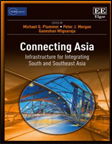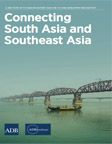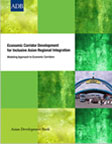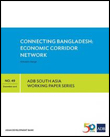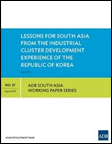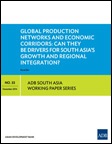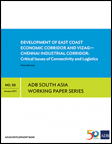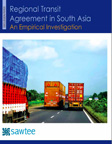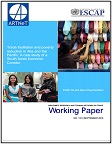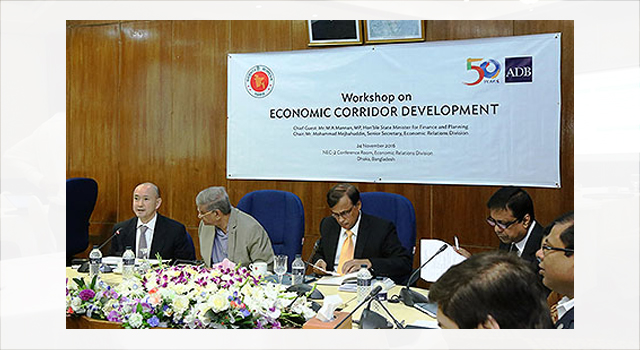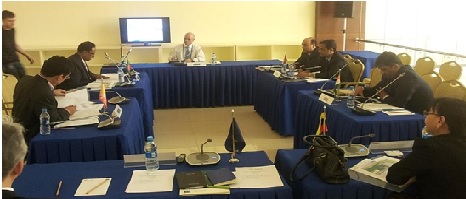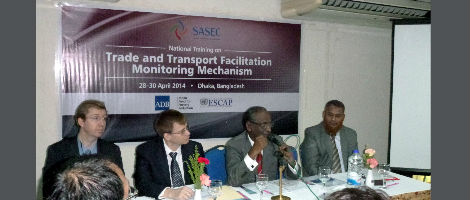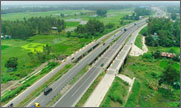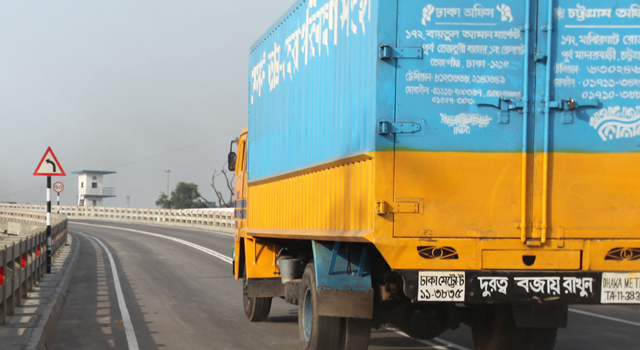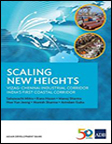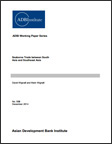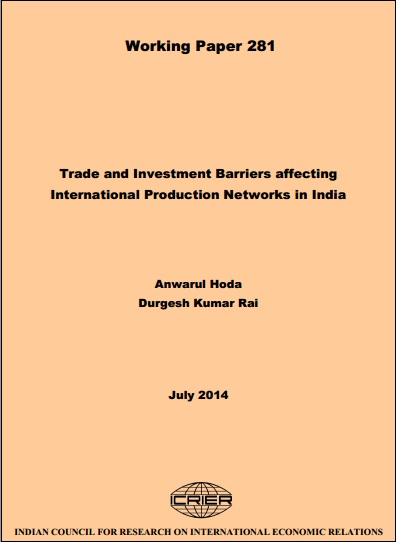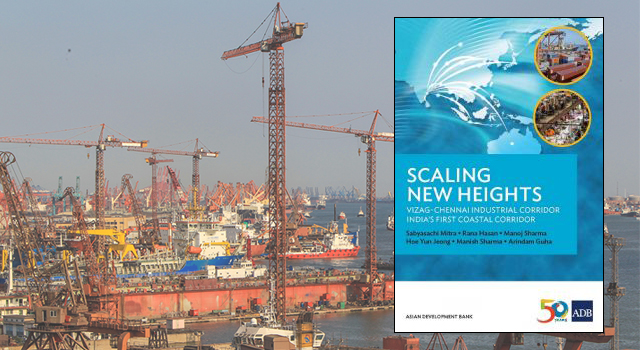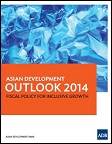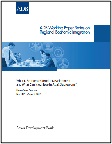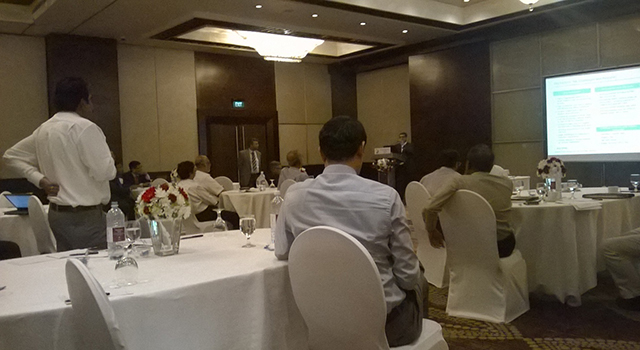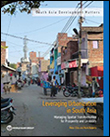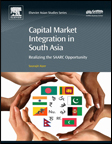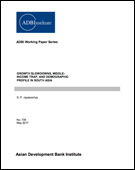Economic Corridor Development
Economic corridor development (ECD) involves the creation of an efficient multimodal transport network supported by quality infrastructure, logistics, and policy framework for ease of doing business, and distribution networks that link production centers, urban clusters, and international gateways, beyond the narrow space of a transport route. Individual SASEC countries are pursuing ECD to bring economic transformation and inclusive growth. SASEC support for economic corridors includes a regional approach in promoting synergies and identifying complementarities between national economic corridors and SASEC member countries, and improving cross-border links to optimize economic corridor investments.
Search by Topic
Suggested Topics
PUBLICATIONS
showing 3 of 10 VIEW ALLThis book contains background papers prepared for the Asian Development Bank and the Asian Development Bank Institute joint study, 'Connecting South Asia and Southeast Asia.' It emphasizes the potential contribution to growth that greater connectivity—through better transport and energy infrastructure and improved soft infrastructure, including trade facilitation—between South Asia and Southeast Asia can foster. With benefits including greater participation in global supply chains for South Asia; lower trade costs; and increase in inter- and intraregional trade, the book underscores that, at a juncture where closer regional integration can secure sustainable and inclusive growth for economies in the two regions, specific policies should be examined and considered to enable both regions to maximize gains from greater integration.
Source: Michael G. Plummer, Peter J. Morgan, Ganeshan Wignaraja, eds.
This book analyzes how closer regional connectivity and economic integration between South Asia and Southeast Asia can benefit both subregions. It aims to build a broad case for increased connectivity between the two regions and identify specific projects that have high potential to fulfill this objective. This joint study focuses on both “hard” infrastructure and associated “soft” infrastructure, including tariffs and non-tariff barriers, trade and transport facilitation, energy trading, and infrastructure investment and financing. It further provides a canvas for considering strategic cross-border infrastructure investments and policy reforms.
Source: Asian Development Bank Institute and Asian Development Bank
The experience of economic corridor development in different regions across continents is examined in this publication, which shares detailed models that assess the economic impact of corridor investments. The South Asia Subregional Economic Cooperation (SASEC) model highlights the regionally inequitable impact of corridor projects and focuses on the incremental effects of infrastructure investments in terms of gains in per capita income.
Source: Asian Development Bank
WORKING PAPER
showing 3 of 4 VIEW ALLEconomic corridors anchored on transport connectivity could significantly boost Bangladesh's economic growth. This paper presents a new set of corridors for Bangladesh – a nine-corridor comprehensive integrated multimodal economic corridor network that will enhance Bangladesh’s role as land bridge between South Asia and Southeast Asia, and between South Asia and northern Asia. These proposed corridors are designed to sustain robust economic growth over the long term by improving regional connectivity, transit, and integration, alongside trade facilitation measures.
Source: Mohuiddin Alamgir
Growth of manufacturing is crucial for economic growth and poverty reduction. This report highlights the industrial cluster development policy of the Republic of Korea, including its success factors in terms of policy implementation, and the promotion of industrial cluster development, drawing lessons that could enhance industrial growth in South Asia. It discusses how the government encouraged increase in exports through relevant policies and adapted to more technology- and knowledge-intensive industries which required innovation-driven policies. The experience outlined in the report could benefit large-scale industrial promotion in South Asia, such as the Economic Corridor Program in India.
Source: Jong-il Kim
This Asian Development Bank South Asia Working Paper examines the role of regional and national economic corridors in facilitating access of South Asian countries to global production networks (GPNs), particularly East Asia and Southeast Asia. It also reviews the state of regional trade integration and examines the nature of engagement in South Asia, specifically India, with its dynamic and high growth GPNs. The paper further identifies key factors that constrain engagement of South Asian countries with East and Southeast Asia in GPN trade.
Source: Kunal Sen
REPORTS
showing 3 of 4 VIEW ALLThe East Coast Economic Corridor (ECEC)—India’s first coastal corridor—is an integrated economic development initiative that is expected to help pursue industrialization and integrate domestic companies into the global value chains of Southeast Asia and East Asia. Its development will start with Vizag–Chennai Industrial Corridor (VCIC), which covers about 800 kilometers and includes several ports and major industrial centers. This paper discusses strategies to consider when trying to improve shipping and air connectivity in the ECEC and Vizag–Chennai Industrial Corridor (VCIC). It stresses the importance of infrastructure development and regulatory reforms that facilitate increased connectivity.
Source: Pritam Banerjee
This discussion paper published by the South Asia Watch on Trade, Economics and Environment assesses the potential gains of a sub-regional transit arrangement and the removal of other border-trade barriers, particularly the eastern South Asia sub-region (Bangladesh, Bhutan, India and Nepal). It also discusses the link between transit and trade flows, provides profiles of intra-regional transit trade and current transit arrangements in South Asia, and identifies efficient regional transit corridors using linear programming or the Data Envelopment Analysis model.
Source: Prabir De and Arvind Kumar
This study assesses the potential impact of trade facilitation on poverty reduction in the region under SAARC Corridor 1, which is one of the leading corridors in South Asia and handles overland trade between Bangladesh, India and Pakistan. Poverty reduction depends on decreasing trade barriers through better trade facilitation and improved infrastructure.
EVENT MATERIALS
showing 3 of 10 VIEW ALL2016-11-24, Dhaka, Bangladesh
2014-05-03, Astana, Kazakhstan
2014-04-28, Dhaka, Bangladesh
Overview
BPA Methodology
- Module 2: BPA Intro
- Module 3.1: BPA Scoping
- Module 3.2: BPA Planning
- Module 4: BPA Techniques for Data Collection and Recording
- Module 5.1: Using BPA Techniques for Identifying Bottlenecks
- Module 5.2: BPA Recommending Improvement
TRS Methodology
- TRS Overview, Purpose, and Methodology
- TRS Members Experience
- TRS Process Mapping
- Practice on TRS Software
TCD Methodology
TTFMM Integrated Methodology
NEWS & MULTIMEDIA
showing 3 of 13 VIEW ALLThe Asian Development Bank (ADB) study on Bangladesh Economic Corridor Development assesses the economic potential of the northeast and southwest Bangladesh regions to propose the holistic development of the country to achieve inclusive and sustainable development.
Japan has proposed the development of a new industrial hub for the Bay of Bengal region. The hub, planned to be built in Bangladesh, will be equipped with supply chains that are connected to India's northeastern region. It will also be linked to Bhutan and Nepal through a planned port and transportation infrastructure.
Good connectivity reduces the cost of doing business and increases the competitive strengths of trading partners. In this commentary, Dr. Mustafizur Rahman, Executive Director, Centre for Policy Dialogue, highlights how a sanitary and phytosanitary agreement and an effective Bangladesh-Bhutan-India-Nepal Motor Vehicle Agreement would promote South Asian integration and step up Asia-wide cooperation.
PUBLICATIONS
showing 3 of 11 VIEW ALLThis book provides policymakers with a guide to understanding India’s economic corridor development strategy by examining its first coastal economic corridor, the East Coast Economic Corridor. It lays out the plan for its first phase, the Vizag–Chennai Industrial Corridor, which can help unify the country's domestic market, integrate its economy with Asia's global value chains, and support the 'Make in India' initiative to spur manufacturing through construction of world-class infrastructure supported by a major transport network, connecting urban clusters complemented by vibrant industrial zones, and encouraging a favorable and competitive environment for businesses to thrive, and facilitating efficient movement of goods and people. As a policy instrument and development strategy, economic corridors can help fast-track inclusive and sustainable economic growth, stimulate rapid industrialization and increase productivity, promote investments, and expand regional connectivity.
Source: Sabyasachi Mitra, Rana Hasan, Manoj Sharma, Hoe Yun Jeong, Manish Sharma, and Arindam Guha
This book contains background papers prepared for the Asian Development Bank and the Asian Development Bank Institute joint study, 'Connecting South Asia and Southeast Asia.' It emphasizes the potential contribution to growth that greater connectivity—through better transport and energy infrastructure and improved soft infrastructure, including trade facilitation—between South Asia and Southeast Asia can foster. With benefits including greater participation in global supply chains for South Asia; lower trade costs; and increase in inter- and intraregional trade, the book underscores that, at a juncture where closer regional integration can secure sustainable and inclusive growth for economies in the two regions, specific policies should be examined and considered to enable both regions to maximize gains from greater integration.
Source: Michael G. Plummer, Peter J. Morgan, Ganeshan Wignaraja, eds.
This book analyzes how closer regional connectivity and economic integration between South Asia and Southeast Asia can benefit both subregions. It aims to build a broad case for increased connectivity between the two regions and identify specific projects that have high potential to fulfill this objective. This joint study focuses on both “hard” infrastructure and associated “soft” infrastructure, including tariffs and non-tariff barriers, trade and transport facilitation, energy trading, and infrastructure investment and financing. It further provides a canvas for considering strategic cross-border infrastructure investments and policy reforms.
Source: Asian Development Bank Institute and Asian Development Bank
WORKING PAPER
showing 3 of 4 VIEW ALLGrowth of manufacturing is crucial for economic growth and poverty reduction. This report highlights the industrial cluster development policy of the Republic of Korea, including its success factors in terms of policy implementation, and the promotion of industrial cluster development, drawing lessons that could enhance industrial growth in South Asia. It discusses how the government encouraged increase in exports through relevant policies and adapted to more technology- and knowledge-intensive industries which required innovation-driven policies. The experience outlined in the report could benefit large-scale industrial promotion in South Asia, such as the Economic Corridor Program in India.
Source: Jong-il Kim
This Asian Development Bank Institute paper examines trade and the main ports around the Bay of Bengal to identify projects that will enable trade and contribute to improved maritime infrastructure. It also reviews the nature of trade and trade patterns, particularly through the Indian East Coast Corridor study. The paper develops further strategic options for seaport adjustment around the Bay of Bengal to support trade evolution, policy assessment, and other constraints.
Source: David Wignall, Mark Wignall
This Asian Development Bank South Asia Working Paper examines the role of regional and national economic corridors in facilitating access of South Asian countries to global production networks (GPNs), particularly East Asia and Southeast Asia. It also reviews the state of regional trade integration and examines the nature of engagement in South Asia, specifically India, with its dynamic and high growth GPNs. The paper further identifies key factors that constrain engagement of South Asian countries with East and Southeast Asia in GPN trade.
Source: Kunal Sen
REPORTS
showing 3 of 7 VIEW ALLThe East Coast Economic Corridor (ECEC)—India’s first coastal corridor—is an integrated economic development initiative that is expected to help pursue industrialization and integrate domestic companies into the global value chains of Southeast Asia and East Asia. Its development will start with Vizag–Chennai Industrial Corridor (VCIC), which covers about 800 kilometers and includes several ports and major industrial centers. This paper discusses strategies to consider when trying to improve shipping and air connectivity in the ECEC and Vizag–Chennai Industrial Corridor (VCIC). It stresses the importance of infrastructure development and regulatory reforms that facilitate increased connectivity.
Source: Pritam Banerjee
This discussion paper published by the South Asia Watch on Trade, Economics and Environment assesses the potential gains of a sub-regional transit arrangement and the removal of other border-trade barriers, particularly the eastern South Asia sub-region (Bangladesh, Bhutan, India and Nepal). It also discusses the link between transit and trade flows, provides profiles of intra-regional transit trade and current transit arrangements in South Asia, and identifies efficient regional transit corridors using linear programming or the Data Envelopment Analysis model.
Source: Prabir De and Arvind Kumar
Recognizing India as an outlier in development of international production networks with the lowest participation among Asian countries, this study investigates the reason for India’s lackluster participation in production-sharing networks. Using desk work, field surveys, and interviews, an analysis is adopted with three comparator countries in the region that have been successful in production-sharing arrangements as well as industrial growth – China, Malaysia, and Thailand. It further describes foreign direct investment inflows into India, analyzes behind-the-border investment environment, and provides recommendations to improve investment climate and hasten the pace of manufacturing development in India.
EVENT MATERIALS
showing 3 of 13 VIEW ALL2017-02-21, Chennai, India
2016-11-10, Delhi, India
2016-05-03, Frankfurt, Germany
NEWS & MULTIMEDIA
showing 3 of 25 VIEW ALLThe Asian Development Bank (ADB) and the government of West Bengal, India, are undertaking a study for the development of economic corridors across the nodes of Andal-Panagarh, Kharagapur-Goaltore-Salboni and growth centers including Siliguri, Dankuni, and Kalyani with urban-industrial logistics-skills-energy-social sector convergence.
The Asian Development Bank (ADB) submitted a feasibility study on the North East Economic Corridor. Features of the report include emphasis on development of transport, urban, and energy infrastructures, as enablers for equitable economic development for India's northeastern region.
Mr. G Kishan Reddy, Minister for Culture, Tourism, and Development of North Eastern Region of the Government of India, lauded the Asian Development Bank for the excellent study carried out on the planned economic corridor in India’s northeastern region. He stated that the ministry will support the implementation of the ambitious projects for the economic corridor.
PUBLICATIONS
showing 3 of 9 VIEW ALLThis book contains background papers prepared for the Asian Development Bank and the Asian Development Bank Institute joint study, 'Connecting South Asia and Southeast Asia.' It emphasizes the potential contribution to growth that greater connectivity—through better transport and energy infrastructure and improved soft infrastructure, including trade facilitation—between South Asia and Southeast Asia can foster. With benefits including greater participation in global supply chains for South Asia; lower trade costs; and increase in inter- and intraregional trade, the book underscores that, at a juncture where closer regional integration can secure sustainable and inclusive growth for economies in the two regions, specific policies should be examined and considered to enable both regions to maximize gains from greater integration.
Source: Michael G. Plummer, Peter J. Morgan, Ganeshan Wignaraja, eds.
This book analyzes how closer regional connectivity and economic integration between South Asia and Southeast Asia can benefit both subregions. It aims to build a broad case for increased connectivity between the two regions and identify specific projects that have high potential to fulfill this objective. This joint study focuses on both “hard” infrastructure and associated “soft” infrastructure, including tariffs and non-tariff barriers, trade and transport facilitation, energy trading, and infrastructure investment and financing. It further provides a canvas for considering strategic cross-border infrastructure investments and policy reforms.
Source: Asian Development Bank Institute and Asian Development Bank
The Asian Development Outlook, ADB’s flagship economic publication provides comprehensive macroeconomic analysis in Asia including growth projections by country and region. The Asian Development Outlook 2014 forecasts that developing Asia will grow 6.2% in 2014 and 6.4% in 2015. South Asia remains one of the slowest growing subregions—although growth is forecast to improve by 5.3% in 2014 and 5.8% in 2015.
Source: Asian Development Bank
Growth of manufacturing is crucial for economic growth and poverty reduction. This report highlights the industrial cluster development policy of the Republic of Korea, including its success factors in terms of policy implementation, and the promotion of industrial cluster development, drawing lessons that could enhance industrial growth in South Asia. It discusses how the government encouraged increase in exports through relevant policies and adapted to more technology- and knowledge-intensive industries which required innovation-driven policies. The experience outlined in the report could benefit large-scale industrial promotion in South Asia, such as the Economic Corridor Program in India.
Source: Jong-il Kim
This Asian Development Bank South Asia Working Paper examines the role of regional and national economic corridors in facilitating access of South Asian countries to global production networks (GPNs), particularly East Asia and Southeast Asia. It also reviews the state of regional trade integration and examines the nature of engagement in South Asia, specifically India, with its dynamic and high growth GPNs. The paper further identifies key factors that constrain engagement of South Asian countries with East and Southeast Asia in GPN trade.
Source: Kunal Sen
This Asian Development Bank Institute paper examines trade and the main ports around the Bay of Bengal to identify projects that will enable trade and contribute to improved maritime infrastructure. It also reviews the nature of trade and trade patterns, particularly through the Indian East Coast Corridor study. The paper develops further strategic options for seaport adjustment around the Bay of Bengal to support trade evolution, policy assessment, and other constraints.
Source: David Wignall, Mark Wignall
This discussion paper published by the South Asia Watch on Trade, Economics and Environment assesses the potential gains of a sub-regional transit arrangement and the removal of other border-trade barriers, particularly the eastern South Asia sub-region (Bangladesh, Bhutan, India and Nepal). It also discusses the link between transit and trade flows, provides profiles of intra-regional transit trade and current transit arrangements in South Asia, and identifies efficient regional transit corridors using linear programming or the Data Envelopment Analysis model.
Source: Prabir De and Arvind Kumar
Economic corridors connect economic agents along a defined geography. They provide important connections between economic nodes or hubs that are usually centered in urban landscapes. They do not stand alone, as their role in regional economic development can be comprehended only in terms of the network effects that they induce.
Source: Hans-Peter Brunner
EVENT MATERIALS
showing 3 of 6 VIEW ALL2016-11-18, Colombo, Sri Lanka
2016-11-02, Colombo, Sri Lanka
2014-05-03, Astana, Kazakhstan
The six member countries of the South Asia Subregional Economic Cooperation Program have launched the SASEC Operational Plan for 2016-2025. The plan expands the program’s focus beyond intraregional cooperation to deepening linkages with Southeast and East Asia, and widens the scope of transport, trade facilitation, and energy cooperation to include economic corridor development as a priority initiative. The plan also lists more than 200 potential regional projects for South Asia.
The economic corridor development (ECD) strategy is an approach that integrates and synergizes industry, infrastructure, and urbanization through meticulous planning over a long-term horizon. An Asian Development Bank (ADB) blog post by Mr. Hoe Yun Jeong, Senior Economist (Regional Cooperation), South Asia Regional Department, published on 26 July 2016, shares how an ECD approach can be beneficial for the South Asia region.
Dr. Selim Reihan notes that drivers of political economy can impact the region's integration agenda. In this essay, Dr. Raihan highlights the importance of exploring the political economy of regional integration to generate a better assessment of the factors driving and constraining regional integration, and create broader awareness among stakeholders to stimulate a more realistic and effective regional policy design and processes.
PUBLICATIONS
showing 3 of 16 VIEW ALLAs South Asian economies improve, they have the potential to greatly improve their prosperity and livability for the people of the region by improving their state of urbanization. Messy and hidden urbanization that leads to slums and sprawls is the result of failure to address congestion constraints arising from rapid growth of urban populations. This book examines the state of South Asia's urbanization – it reviews gaps in markets and policies that have hindered its proper growth, and discusses key policy areas that must be undertaken, including improvement in housing provisions, infrastructure, and basic services.
Source: Peter Ellis and Mark Roberts
This book contains background papers prepared for the Asian Development Bank and the Asian Development Bank Institute joint study, 'Connecting South Asia and Southeast Asia.' It emphasizes the potential contribution to growth that greater connectivity—through better transport and energy infrastructure and improved soft infrastructure, including trade facilitation—between South Asia and Southeast Asia can foster. With benefits including greater participation in global supply chains for South Asia; lower trade costs; and increase in inter- and intraregional trade, the book underscores that, at a juncture where closer regional integration can secure sustainable and inclusive growth for economies in the two regions, specific policies should be examined and considered to enable both regions to maximize gains from greater integration.
Source: Michael G. Plummer, Peter J. Morgan, Ganeshan Wignaraja, eds.
This book discusses the potential capital market products and activities within South Asia that stakeholders in the region could explore to help the South Asian Association for Regional Cooperation (SAARC) region further realize its potential. Conventional investment, such as funds, global depository receipts, as well as promising opportunities that factor the region's demographics and socioeonomics are considered in this book, with arguments aimed toward investors and institutions. The book demonstrates both retail and institutional investor interest in this combined high-growth region by offering scope for yield, diversification and risk mitigation, maximized upside from multiple growth markets, minimized downside through low-correlation constituents, and makes the case why now is an opportune time to look at SAARC.
Source: Sourajit Aiyer
WORKING PAPER
showing 3 of 6 VIEW ALLThis paper examines how investment in human capital is critical for innovation. Analyzing the different growth-promoting factors in South Asian economies, with a focus on demographics, and factors that can help shift middle-income countries to high-income countries, it concludes that economic transition is affected by firms’ productive advantages—ability to compete with high-skilled producers, low-wage exporters—and education-based growth, which can help advance the country's technological capacity.
Source: S. P. Jayasooriya
Economic corridors anchored on transport connectivity could significantly boost Bangladesh's economic growth. This paper presents a new set of corridors for Bangladesh – a nine-corridor comprehensive integrated multimodal economic corridor network that will enhance Bangladesh’s role as land bridge between South Asia and Southeast Asia, and between South Asia and northern Asia. These proposed corridors are designed to sustain robust economic growth over the long term by improving regional connectivity, transit, and integration, alongside trade facilitation measures.
Source: Mohuiddin Alamgir
Growth of manufacturing is crucial for economic growth and poverty reduction. This report highlights the industrial cluster development policy of the Republic of Korea, including its success factors in terms of policy implementation, and the promotion of industrial cluster development, drawing lessons that could enhance industrial growth in South Asia. It discusses how the government encouraged increase in exports through relevant policies and adapted to more technology- and knowledge-intensive industries which required innovation-driven policies. The experience outlined in the report could benefit large-scale industrial promotion in South Asia, such as the Economic Corridor Program in India.
Source: Jong-il Kim
REPORTS
showing 3 of 8 VIEW ALLThe East Coast Economic Corridor (ECEC)—India’s first coastal corridor—is an integrated economic development initiative that is expected to help pursue industrialization and integrate domestic companies into the global value chains of Southeast Asia and East Asia. Its development will start with Vizag–Chennai Industrial Corridor (VCIC), which covers about 800 kilometers and includes several ports and major industrial centers. This paper discusses strategies to consider when trying to improve shipping and air connectivity in the ECEC and Vizag–Chennai Industrial Corridor (VCIC). It stresses the importance of infrastructure development and regulatory reforms that facilitate increased connectivity.
Source: Pritam Banerjee
This discussion paper published by the South Asia Watch on Trade, Economics and Environment assesses the potential gains of a sub-regional transit arrangement and the removal of other border-trade barriers, particularly the eastern South Asia sub-region (Bangladesh, Bhutan, India and Nepal). It also discusses the link between transit and trade flows, provides profiles of intra-regional transit trade and current transit arrangements in South Asia, and identifies efficient regional transit corridors using linear programming or the Data Envelopment Analysis model.
Source: Prabir De and Arvind Kumar
Recognizing India as an outlier in development of international production networks with the lowest participation among Asian countries, this study investigates the reason for India’s lackluster participation in production-sharing networks. Using desk work, field surveys, and interviews, an analysis is adopted with three comparator countries in the region that have been successful in production-sharing arrangements as well as industrial growth – China, Malaysia, and Thailand. It further describes foreign direct investment inflows into India, analyzes behind-the-border investment environment, and provides recommendations to improve investment climate and hasten the pace of manufacturing development in India.
EVENT MATERIALS
showing 3 of 19 VIEW ALL2017-02-21, Chennai, India
2016-11-24, Dhaka, Bangladesh
2016-11-18, Colombo, Sri Lanka
NEWS & MULTIMEDIA
showing 3 of 34 VIEW ALLThe Asian Development Bank (ADB) and the government of West Bengal, India, are undertaking a study for the development of economic corridors across the nodes of Andal-Panagarh, Kharagapur-Goaltore-Salboni and growth centers including Siliguri, Dankuni, and Kalyani with urban-industrial logistics-skills-energy-social sector convergence.
The Asian Development Bank (ADB) study on Bangladesh Economic Corridor Development assesses the economic potential of the northeast and southwest Bangladesh regions to propose the holistic development of the country to achieve inclusive and sustainable development.
Japan has proposed the development of a new industrial hub for the Bay of Bengal region. The hub, planned to be built in Bangladesh, will be equipped with supply chains that are connected to India's northeastern region. It will also be linked to Bhutan and Nepal through a planned port and transportation infrastructure.

